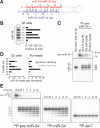The 3'-to-5' exoribonuclease Nibbler shapes the 3' ends of microRNAs bound to Drosophila Argonaute1
- PMID: 22055293
- PMCID: PMC3236499
- DOI: 10.1016/j.cub.2011.09.034
The 3'-to-5' exoribonuclease Nibbler shapes the 3' ends of microRNAs bound to Drosophila Argonaute1
Abstract
Background: MicroRNAs (miRNAs) are ~22 nucleotide (nt) small RNAs that control development, physiology, and pathology in animals and plants. Production of miRNAs involves the sequential processing of primary hairpin-containing RNA polymerase II transcripts by the RNase III enzymes Drosha in the nucleus and Dicer in the cytoplasm. miRNA duplexes then assemble into Argonaute proteins to form the RNA-induced silencing complex (RISC). In mature RISC, a single-stranded miRNA directs the Argonaute protein to bind partially complementary sequences, typically in the 3' untranslated regions of messenger RNAs, repressing their expression.
Results: Here, we show that after loading into Argonaute1 (Ago1), more than a quarter of all Drosophila miRNAs undergo 3' end trimming by the 3'-to-5' exoribonuclease Nibbler (CG9247). Depletion of Nibbler by RNA interference (RNAi) reveals that miRNAs are frequently produced by Dicer-1 as intermediates that are longer than ~22 nt. Trimming of miRNA 3' ends occurs after removal of the miRNA* strand from pre-RISC and may be the final step in RISC assembly, ultimately enhancing target messenger RNA repression. In vivo, depletion of Nibbler by RNAi causes developmental defects.
Conclusions: We provide a molecular explanation for the previously reported heterogeneity of miRNA 3' ends and propose a model in which Nibbler converts miRNAs into isoforms that are compatible with the preferred length of Ago1-bound small RNAs.
Copyright © 2011 Elsevier Ltd. All rights reserved.
Figures





Similar articles
-
The exoribonuclease Nibbler controls 3' end processing of microRNAs in Drosophila.Curr Biol. 2011 Nov 22;21(22):1888-93. doi: 10.1016/j.cub.2011.10.006. Epub 2011 Nov 3. Curr Biol. 2011. PMID: 22055292 Free PMC article.
-
Intertwined pathways for Argonaute-mediated microRNA biogenesis in Drosophila.Nucleic Acids Res. 2014 Feb;42(3):1987-2002. doi: 10.1093/nar/gkt1038. Epub 2013 Nov 12. Nucleic Acids Res. 2014. PMID: 24220090 Free PMC article.
-
Structural determinants of miRNAs for RISC loading and slicer-independent unwinding.Nat Struct Mol Biol. 2009 Sep;16(9):953-60. doi: 10.1038/nsmb.1630. Epub 2009 Aug 16. Nat Struct Mol Biol. 2009. PMID: 19684602
-
The RNAi pathway initiated by Dicer-2 in Drosophila.Cold Spring Harb Symp Quant Biol. 2006;71:39-44. doi: 10.1101/sqb.2006.71.008. Cold Spring Harb Symp Quant Biol. 2006. PMID: 17381278 Review.
-
Intracellular localization and routing of miRNA and RNAi pathway components.Curr Top Med Chem. 2012;12(2):79-88. doi: 10.2174/156802612798919132. Curr Top Med Chem. 2012. PMID: 22196276 Review.
Cited by
-
MUT-16 promotes formation of perinuclear mutator foci required for RNA silencing in the C. elegans germline.Genes Dev. 2012 Jul 1;26(13):1433-44. doi: 10.1101/gad.193904.112. Epub 2012 Jun 19. Genes Dev. 2012. PMID: 22713602 Free PMC article.
-
MUT-7 exoribonuclease activity and localization are mediated by an ancient domain.Nucleic Acids Res. 2024 Aug 27;52(15):9076-9091. doi: 10.1093/nar/gkae610. Nucleic Acids Res. 2024. PMID: 39188014 Free PMC article.
-
Exosomal miRNAs and isomiRs: potential biomarkers for type 2 diabetes mellitus.Precis Clin Med. 2024 Sep 20;7(3):pbae021. doi: 10.1093/pcmedi/pbae021. eCollection 2024 Sep. Precis Clin Med. 2024. PMID: 39347441 Free PMC article. Review.
-
Dicer partner proteins tune the length of mature miRNAs in flies and mammals.Cell. 2012 Oct 26;151(3):533-46. doi: 10.1016/j.cell.2012.09.027. Epub 2012 Oct 11. Cell. 2012. PMID: 23063653 Free PMC article.
-
Structural and biochemical insights into small RNA 3' end trimming by Arabidopsis SDN1.Nat Commun. 2018 Sep 4;9(1):3585. doi: 10.1038/s41467-018-05942-7. Nat Commun. 2018. PMID: 30181559 Free PMC article.
References
-
- Filipowicz W, Bhattacharyya SN, Sonenberg N. Mechanisms of post-transcriptional regulation by microRNAs: are the answers in sight? Nat Rev Genet. 2008;9:102–114. - PubMed
-
- Lee RC, Feinbaum RL, Ambros V. The C. elegans heterochronic gene lin-4 encodes small RNAs with antisense complementarity to lin-14. Cell. 1993;75:843–854. - PubMed
-
- Wightman B, Ha I, Ruvkun G. Posttranscriptional regulation of the heterochronic gene lin-14 by lin-4 mediates temporal pattern formation in C. elegans. Cell. 1993;75:855–862. - PubMed
-
- Bushati N, Cohen SM. microRNA functions. Annu Rev Cell Dev Biol. 2007;23:175–205. - PubMed
Publication types
MeSH terms
Substances
Grants and funding
LinkOut - more resources
Full Text Sources
Other Literature Sources
Molecular Biology Databases
Research Materials

